
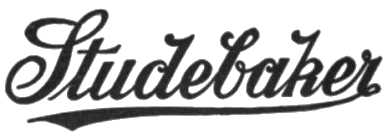 : the loss of an American icon
: the loss of an American icon
by John Morris
In October 2003, I led a group of Nottinghamshire teachers on a study visit to Toronto. We spent time looking at exciting research from the university and visiting some fantastic schools. During the down time, I took a Greyhound bus around the western end of Lake Ontario to Niagara Falls. The bus passed through the industrial city of Hamilton the once home of Studebaker (Canada).
Founded by five German brothers, immigrants to the United States, as a wagon and coach maker in 1852, the Studebaker Corporation opened its Hamiliton factory on 18th August 1948. They chose the city for what became known as one of Canada’s most modern and up-to-date plants, because of its location at the heart of the Canadian steel industry, figure 1.

The first vehicle off the production line was the Champion Starlight coupe, which prompted the joke that one could not tell whether it was coming or going.
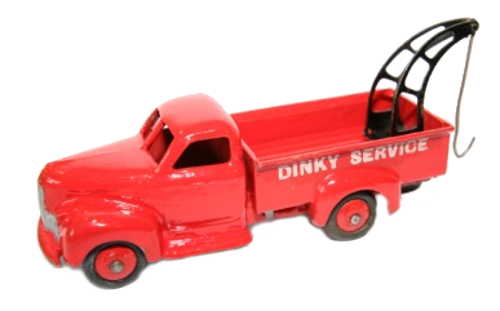
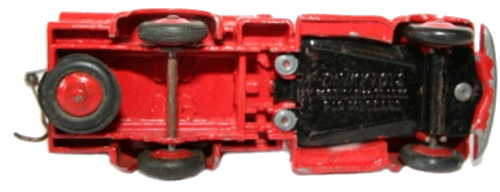
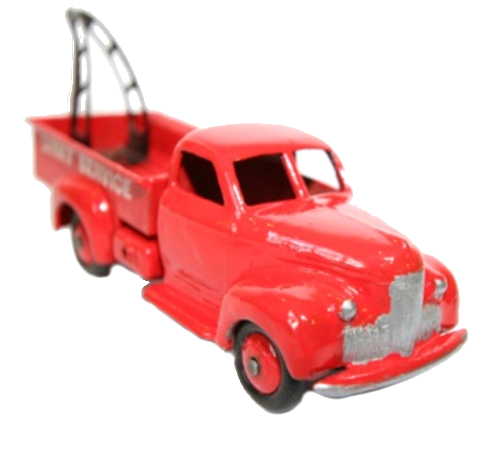
At a local swapmeet, a French Dinky, Studebaker dépannage (breakdown truck) 25R caught my eye. When researching the background to the model, I discovered the excellent website, diecast.plus.com, but that no pictures of the model 25R were available. Therefore, I submitted my photographs, figure 2, and some text, which are now on the website.
First produced in 1949 and based on the Studebaker M-series pick-up truck, the photographs show the 1950 model, where rubber tyres replaced the original ‘red metal’ wheels. In France, the original model sold for 200 francs, slightly less than four shillings (now 40p). The Studebaker breakdown truck was withdrawn in April 1954, replaced by an out-dated and short-lived, but French Mathis/Ford ‘Poissy’ version (25RF/1) - named after the Parisian plant where the trucks were manufactured.
There are two variants of this model: the first includes curved wings with a large space between them and the front bumper. There is a kind of toolbox molded on the right step. The cap is provided with a molding. The second variant has larger wings and no gap between them and the front bumper, the roof is flatter and wider and, the windows are larger. The toolbox is represented by an edge, the wand and the badge on the hood are thinner and lateral veins more clearly defined. This series includes seven references: 25K, 25L and 25M; the 25O, 25P, 25Q and 25R. There are two trailers which fit the 25S and 25T. These have two wheels and a tin cover.
Model 25O, the Camion Laitier, is not the rarest, but is the most attractive. The Studebaker milk truck was made from 1949 to 1954, when it was replaced by a similar vehicle with a Mathis/Ford cab. Supplied with 10 milk churns in a red box, early models had black metal wheels, which were replaced by blue ridged ones with rubber tyres in 1950.
Other Studebaker vehicles included the US army’s US6 truck, the Starliner Commander (Dinky 24Y/172), President (Dinky 179), the Golden Hawk (Corgi 211) and the ubiquitous Dinky (442), the ‘Esso’ tanker (figure 4).
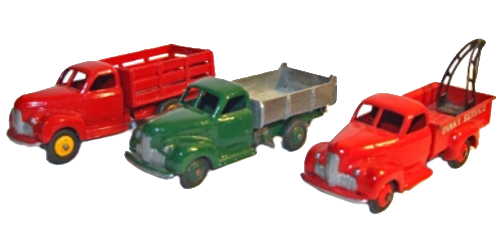
Dépannage 25R, (left-right).
First produced in 1954, the tanker was based on the Studebaker 2.5 ton truck, which, in reality, also appeared as a fire engine, in Neshanic, New Jersey, and as an open-topped, canopy covered tour-bus for Handford, California.
The model featured the livery of several different oil companies, ‘Mobilgas’ (440), ‘Castrol’ (441) and ‘National Benzole’ (443). Dinky withdrew the model in 1960.
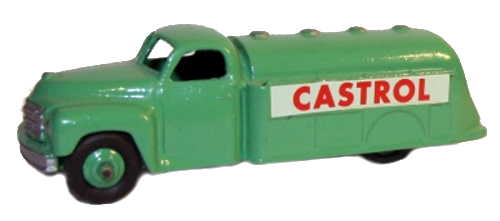
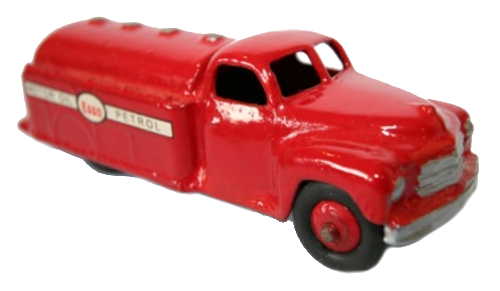
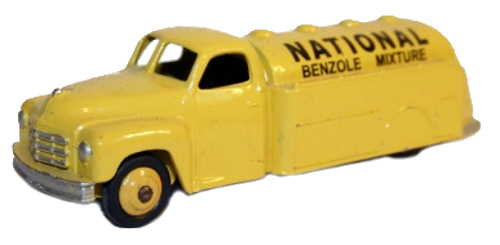
‘Esso’ tanker and ‘National Benzole’ 443
In France and the UK Dinky produced the Studebaker State Commander Coupe (240/39f), which sold for 10 old pence (10d). Designed by Raymond Loewy, the car was unquestionably South Bend's finest and often regarded as the best Studebakers of all time. Some of its features appear in modern Hondas and Pontiacs. Released in 1939, the model was withdrawn in 1950.
In 1955, the French produced the Studebaker Commander Starliner Coupe (24Y), which was available in orange and cream or a two tone green finish, was based upon a new 1953 vehicle designed for the American market.
The introduction of Studebaker’s Starliner represented the first entirely new body style since 1947. The coupe was so attractive that orders were more numerous than predicted. However, the sheet metal work for the coupe was difficult to fit together, which slowed the production process to the point where people who wanted the coupe could not readily get one. This cost Studebaker a lot of potential sales.
The body shell, albeit in a heavily modified form, was used on the Golden Hawk and survived until the end of production in 1966.
The Dinky Studebaker Landcruiser (172) was released in April 1954. In May 1955, the price was two shillings and nine pence (2/9), although the original price was 2/8. Dinky built the Studebaker’s ‘Lazy S’ logo into the casting for the bonnet.
From July 1956, Dinky introduced a two tone colour scheme. The Landcruiser came in green, red and cream or a brown and stone finish.
In the UK and France, Dinky's Studebaker President Sedan (179) was available in blue with mid blue sides or in a yellow and dark blue finish. At 1:46 scale, the model was released in 1958 and withdrawn in 1963.
The Dinky and French Dinky Packard Clipper (180) was released in 1958. Although based on the Studebaker and Christened by car enthusiasts as the ‘Packardbaker’, none were assembled at the Hamilton plant. The Studebaker President Sedan was identical see figure 5. I wonder what 1950’s children made of the similarity between the Dinky toys; – can you spot many differences?
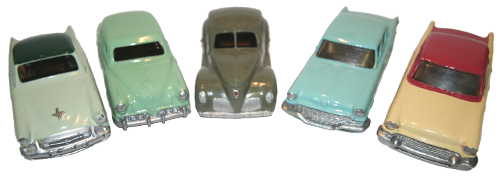
Coupe (24Y); Landcruiser (172); State Commander Coupe (240/39F);
President Sedan (179); and, the Packard Clipper (180).
Parkard’s reputation in the luxury car market was compromised by the company’s own actions. The Clipper model was available in grey and red or in a fawn and red finish.
Dinky Golden Hawk (169) and Corgi (211) Golden Hawk (M/S) The Dinky Studebaker Golden Hawk was advertised and released in November 1958. Its price was three shillings and six pence (3/6). At 1:48 scale, the Golden Hawk had a red or green and cream finish.
Released in February of the same year, the Corgi Studebaker Golden Hawk (211) was fitted with interior windows and suspension.
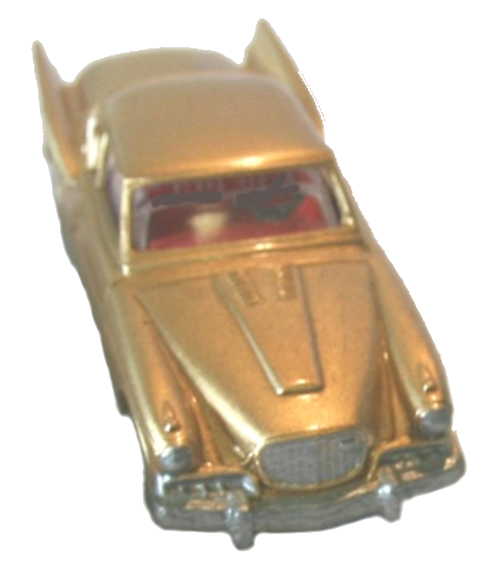
The model labelled 211M had a friction motor and was priced at 3/9. For a further nine old pence (4/6), and at a 1:49 scale, the model was available in Gold Plate (211S) and in a blue or white finish. The model was withdrawn in 1963.
Launched in 1957, the Golden Hawk was the only new American car to have tail fins, which were by then, seriously out of fashion. Studebaker kept production of the Hawk at South Bend, never moving the manufacture to Hamilton.
In 1954 and losing money, Packard, a luxury car-maker, took-over Studebaker, but the decline continued. The merger was not a success, largely because Packard was known for poor quality and reliability at very expensive prices. Studebaker ceased the production of all motor vehicles in 1966. The company’s own reputation for quality and reliability was undermined by poor industrial relations. The public also did not take well to new models, like the Golden Hawk, because it was seen for what it was, the Starliner body shell, with a re-modelled bonnet and tail fins. The cars were based on old designs and technology.
Studebaker first stopped manufacturing cars and trucks at South Bend, Indiana, in 1963. Then, they sold the Packard plant in Detroit and finally, closed the assembly line at Hamilton in March 1966, when the city lost its 10th largest employer.
Thanks to John Morris
Links
- Corgi 211 in detail...
- Corgi 211S in detail...
- Corgi Junior 15 in detail...
- Corgi Junior 30 in detail...
- Dinky 30P in detail...
- Dinky 39F in detail...
- Dinky 39F in detail...
- Dinky 172 in detail...
- Dinky 179 in detail...
- Dinky 440 in detail...
- Dinky 441 in detail...
- Dinky 442 in detail...
- Dinky 443 in detail...
- Dinky Atlas 24O in detail...
- Dinky Atlas 24Y or 540 in detail...
- Dinky Atlas 25L in detail...
- French Dinky 24O in detail...
- French Dinky 24Y in detail...
- French Dinky 25K in detail...
- French Dinky 25L in detail...
- French Dinky 25M in detail...
- French Dinky 25O in detail...
- French Dinky 25R in detail...
- French Dinky 25Q in detail...
- French Dinky 25P in detail...
- French Dinky 179 in detail...
- Husky 15 in detail...
- Husky 30 in detail...
- Matchbox 42B in detail...
- Solido 4521 in detail...